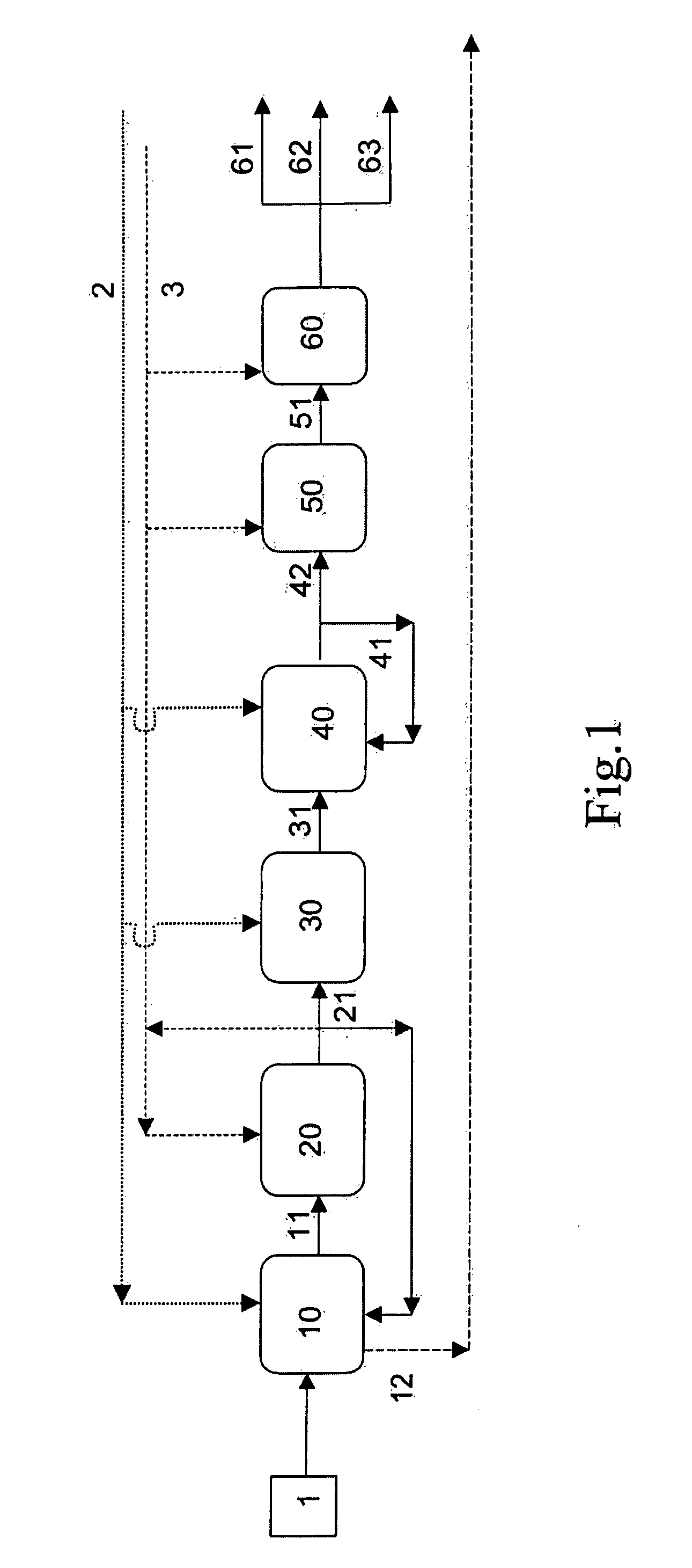Process for the manufacture of base oil
- Summary
- Abstract
- Description
- Claims
- Application Information
AI Technical Summary
Benefits of technology
Problems solved by technology
Method used
Image
Examples
example 1
Manufacture of Alpha-Olefins from Fatty Acids
[0095] Alpha-olefins were produced from distilled C16 fatty acid feed. The alpha-olefins were prepared by feeding 200 g fatty acids together with 1.5 molar excess of C16 fatty alcohol to an autoclave under stirring to form a wax ester through esterification reaction. Esterification took place under atmospheric pressure at a temperature of 250° C. Reaction time was 3 hours. No catalyst was used. Water liberated in the reaction was purged with nitrogen flow of 6 l / h.
[0096] The obtained wax ester and hydrogen were thereafter charged to the fixed bed hydrogenation reactor, where they were brought in contact with a copper-chromite catalyst at 230° C. and 30 MPa pressure, forming C16 fatty alcohols. The product was cooled and the liquid crude fatty alcohol was separated. A part of this prepared fatty alcohol was used in esterification.
[0097] The fatty alcohol obtained above was dehydrated in a flow reactor with zirconia / gamma-alumina catalys...
example 2
Oligomerization of Alpha-Olefins in a Batch Reactor
[0099] 50 g of 1-hexadecene and 2 g of a catalyst were mixed in an autoclave reactor. The catalysts used are shown in Table 3 below. The mixture was heated to 200° C. for 24 hours under nitrogen atmosphere. The pressure was 2.0 MPa. Conversion of the reaction was calculated to all products other than C16.
TABLE 31-hexadecene oligomerizationCatalystBeta 1Beta 2YH-MCM-41C16 conversion (%)Product distribution (wt-%):62777774111113branched C16 =3320923n-C16 =53143C17-C31171836C3228396142C48581120>C481213
[0100] The catalysts used were Y-zeolite (TOSOH Co.), beta-zeolite 1 (TOSOH Co.) and beta-zeolite 2 (TOSOH Co.), and the mesoporous material MCM-41 was prepared according to Catalysis Letters 36 (1996) 103.
[0101] As can be seen in Table 3 a high yield of C32 dimer and C48 trimer is obtained. The C16 monomer residue is mostly branched olefin and after hydrogenation it may suitably be used as a diesel fuel.
example 3
Oligomerization in a Fixed Bed Reactor
[0102] 1-hexadecene was fed to a fixed bed tubular reactor with 5 g catalyst diluted with silicon carbide in ratio 1:3. The catalyst used was mesoporous material MCM-41, described in example 2, the aluminium content of which was 2.5 wt-%, amount of acidic sites 150 μmol / g and surface area of mesopores >800 m2. The reactor temperature was 200° C., the pressure was 2.0 MPa and the feed rate was 10 g / h. The reaction was followed by GC analysis. In Table 4 the conversion and the composition of oligomerization product is presented at different times on stream.
TABLE 41-hexadecene oligomerization in fixed bed reactorTOS (h) (time on stream)Product624304854727896distribution (wt-C16 conversion (%)%):787168646154524732211111Branched C16 =2024242423242321n-C16 =2581216222532C17-C3152111111C324351515049454440C482115141110765>C4861010000
PUM
| Property | Measurement | Unit |
|---|---|---|
| Temperature | aaaaa | aaaaa |
| Temperature | aaaaa | aaaaa |
| Temperature | aaaaa | aaaaa |
Abstract
Description
Claims
Application Information
 Login to View More
Login to View More - R&D
- Intellectual Property
- Life Sciences
- Materials
- Tech Scout
- Unparalleled Data Quality
- Higher Quality Content
- 60% Fewer Hallucinations
Browse by: Latest US Patents, China's latest patents, Technical Efficacy Thesaurus, Application Domain, Technology Topic, Popular Technical Reports.
© 2025 PatSnap. All rights reserved.Legal|Privacy policy|Modern Slavery Act Transparency Statement|Sitemap|About US| Contact US: help@patsnap.com

